Wednesday July 18, 2012
We've been busy here at Heirloom Meals and have gotten a little behind on our radio guest blogs. But we're catching up today and I want to introduce you to three distinct and very interesting people, each of them have a very unique Heirloom story!

Leslie Reichert is commonly known as the "Green Cleaning Coach" as she has returned to her ancestral ways to create a Green Cleaning Recipe book based on the cleaning recipes of her own grandmother. Find out more about how to clean your house using simple natural ingredients such as vinegar and baking soda HERE.
Italian born professor Fabio Parasecoli learned to appreciate food through his travels and co-authored the book "A cultural History of Food". Hear more about his journey to understand culture, history and food HERE.
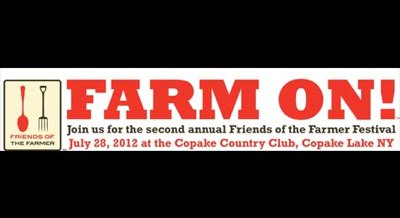
Tessa Edick is a true American-born girl who has used her fond childhood memories based around local food and agriculture to create her adulthood business successes; starting a business called "Sauce 'n Love" and selling it to move on to create the "Friends of the Farmer Festival". Listen to Tesse's story HERE!!!
Friday July 13, 2012
The other day I was looking out at the garden and I realized I had an abundance of collard greens. Without hesitation I quickly emailed my friend Dawn DeAngelis. Some time ago I remember her mentioning she had a great recipe using collard greens. Dawn responded and I thought this would be perfect to feature as one of Carole's Concoctions . Dawn shared her story with me,
"The recipe is not mine. It's from Epicurious. And I still love it. When I moved to New Hampshire form California in 2000, I dearly missed all the fresh veggies and greens I picked up every week at my local farmers market. One day I picked up a Gourmet and found that recipe. I made it countless times that first year, because collards are plentiful in New England markets.I brought it to a pot luck once and the description of Shredded Collard Greens with Walnuts and Pickled Apples was not exactly a big enticement to folks to try the salad. So a friend told me to change the name to:Winter Green Salad with Walnuts and Apples. I did. And the salad is always a hit."
So the interns and I decided to try it out, we picked the collards, and did the pickling of the apples. And this is how the salad turned. We hope you will try this tasty salad. Here are some pictures of how it turned out, it's quite pretty, and yummy too!
The recipe can be found here Winter Green Salad with Walnuts and Apples.
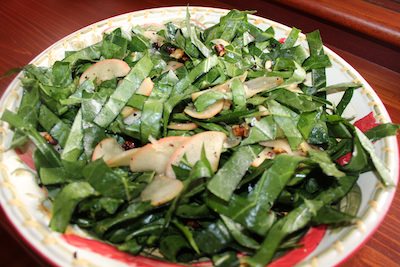
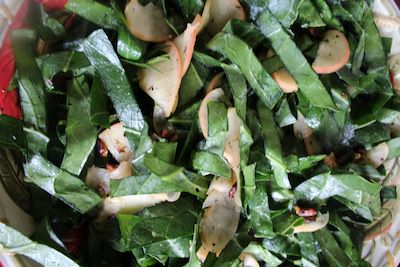
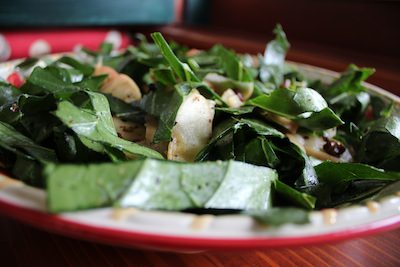
Wednesday July 11, 2012
This week, Carole has asked me to consider the foods that I crave most on returning home to my small mining town, Copperton, in southwestern Utah.
I pondered this a while, as my tastes from early childhood have considerably changed with the exposure to new foods and a stronger sense of where my meals originate and are processed from. As a result, grape juice from concentrate, frozen French fries, and pancakes from quick mixes are now off the list. Regardless of this, I still have a weakness for Kozy Shak’s Tapioca pudding cups and beg my mother profusely to buy them before I return home, so that they are waiting for me in the morning.
My grandmother never cooked more than the odd dry chicken or ham for the holidays when my mom was a kid, so she tells me. Her expertise lay in the sugary confectionary of candies and sweets, which were about the only homemade things that my mom could ever recall her making, to this day. In hindsight to this, my mother has come considerably far in her own meal-making, and there are several, relatively homemade dishes that I find instant comfort and inner peace with as soon as I smell them. Her famous chicken Coq a Vin, for one.
My mother’s job keeps her away from the house most of the day on weekdays and is thus a big fan of the bag-freeze method of making meals that are time consuming. She will often devote an entire day to making the Coq a Vin, cooking it slowly in a huge soup pot for hours, adding in a touch of this and that for seasoning, sticking her wooden spoon in every so often to balance the flavors. Once the chicken is finally cooked, the meat is practically falling off of the bone and is infused with the delicious broth from the pot. Quick as anything, she will lay out handfuls of plastic zip lock bags onto the counter and ladle portions of Coq a Vin into each bag, carefully labeling each bag in black sharpie. Then off to the big freezer downstairs they go, to be slowly consumed over the next few months at the family’s leisure. For me, there is nothing more comforting than coming home for lunch and getting into one of those freezer bags. Even the defrosting part in the microwave is a kind of food ritual in our house. And the Coq a Vin? To die for.
Since coming to Smith College and getting absorbed by Carole’s own food process, I’ve come to appreciate the difference between canned vs. locally grown produce, plantation beef vs. grass fed, and admit that the homemade tapioca pudding that we made several weeks ago, seriously trumps my treasured Kozy Shack cups. I see this as a positive thing, as I am likely to make more meaningful decisions regarding food when I return home in the future, bringing with me the recipes and cooking skills that I have developed over the summer at Heirloom Meals headquarters. I plan to make some killer batches of tapioca, canning them in the fridge for months of enjoyment in the traditional family way. More importantly, it will be my way of giving back to my mother, of saying, “thanks for the home cookin'.”
Friday July 06, 2012
We Want YOUR family Blueberry Recipe!!
July is National Blueberry Month! So here at Heirloom Meals we decided to host a contest to try some of your authentic family favorites that include Blueberries. To enter please follow this link: http://www.facebook.com/HeirloomMealsWithCaroleMurko/app_197602066931325 or comment below. We can't wait to try your recipe!!
Thanks!
Friday July 06, 2012
“Come y bebe, que la vida es breve" ...my madre española, or Spanish host-mom, used to say this phrase to me as we would sit down to eat. Translated it means “eat and drink because life is short”. I was fortunate enough this last year to spend nine months living and studying abroad in Barcelona, Spain. As you can imagine, it was an amazing and life-changing experience. I could go on-and-on about Spain and its interesting history, unique culture and amazing food! Spain is somewhat of a “hidden treasure”. Most people seem to pass over it during their travels and only in recent years has it started to gain recognition. However, after having lived there I have learned how vigorously Spain maintains and treasures its traditions and culture. Ironically, or tastefully in my opinion, many of Spain’s traditions revolve around food. To begin with you have the traditional paella; historically a workman’s meal that is eaten year round and continues to appear at every town’s Fiesta Mayor (Major Festival). When made for these festivals it is large enough to feed thousands of people! Beyond the Paella, Spain is well-known for its Sangria and Tapas dinner (an appetizer-style dinner). And finally each holiday has some kind of traditional food to go along with it. The Spanish are fond of food and love to dine-out with friends. Nevertheless, some of my greatest food memories were at home around the table of my madre española.
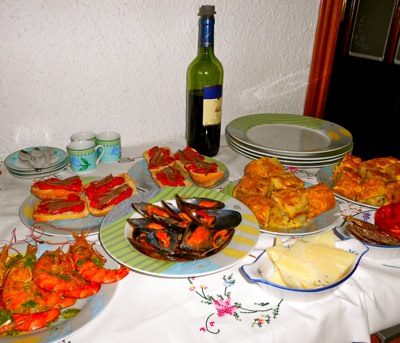
(A traditional Spanish meal my madre española made.)
Spain’s food scene is uniquely diverse. Each region has its own specialties. Living in Barcelona I was in the providence of Cataluña, a politically and culturally unique area from the rest of Spain. However, my padres (Spanish host-parents) were from Valencia and so I got to see a unique blend of the Spanish food traditions. From the time I arrived my madre introduced me to a plentiful array of Spanish food and eventually let me assist her in the kitchen (a rare occurrence by a Spanish madre). The kitchen was my madre’s domain and it was how she showed her love and affection for those closest to her. It was over the food that I bonded with her. I spent many days sitting on a little stole in the kitchen watching her cook and talking with her. She loved food and was particularly appreciated really good, fresh pan (bread) doused with good Spanish olive oil. Almost every morning she would wake-up and go down the street to retrieve freshly baked pan. Greeting people along the way she had been going to the same bakery for the past 30 years and the family considered her a friend. Some mornings she would come home with a surprise croissant for me. I am convinced that Cataluña has better chocolate croissants than France. You may hesitate to agree but Cataluña is known for its bakeries and I could not stay out of them!
One of my favorite things about the Spanish cuisine is the freshness of the food. Each neighborhood has their own Mercado (Market) heaping with fresh fruits, vegetables, fish and meat. During our trips to the Mercado my madre taught me the best tomato is always the heaviest one because they have the most “meat” to them. The Mercado was a meeting place; everyone knew each other and in addition to the food stands there was a bar where people would grab lunch or coffee after their shopping trip. My madre was an amazing cook but the fresh foods only made it better. Often while I sat in the kitchen watching her cook she would come up to me, place a tomato below my nose and tell me to smell its freshness. As I sit here trying to think of my favorite dishes my madre would make I think of the traditional Spanish flavors such as garlic, olive oil, chorizo, rice, onions, seafood, etc. The Spanish flavors remain a prominent memory in my mouth but it was the approach my padres (host-parents) and other Spaniards have towards food that I’ll carry with me.

(Fresh fruit at one of Barcelona's Mercados)
I would frequently come home between classes to sit down and eat lunch with my padres. This is a common practice in Spain and children still make their way home from school to eat lunch with their families. While in Spain I learned how to slow down and appreciate the simple things. For the Spaniards, sitting down to a meal or having something to eat is not just another check on their ‘to-do’ list but is something to enjoy. I’ve make a pact with myself that as I return to Smith College this coming year I will make an effort to sit down for lunch with friends as often as possible. I want to take that little extra time to enjoy the food and the people instead of racing off to complete the things on my checklist.
As I finish up this blog post I must admit that I have only brushed the surface of Spanish food and its culture. If I had more space I would talk about their unique summer dishes such as gazpacho or jamón iberico with melon. I would share the uniqueness of the Catalan pastries in their bakeries and the sweets they made for different holidays. There are also fun, little stories behind different dishes and Spain is brimming with freshly cultivated foods. The more I learned about Spanish food while I was abroad the more I wanted to know, and the more I realized how connected food is to culture. So much of understanding the Spanish culture is understanding the food and the customs around it. For the Spanish, food is connected to tradition, history, family and friends and it is an experience that should be enjoyed everyday. As my madre would say, “Come y bebe, que la vida es breve”. After hearing this for nine months I don’t think I can approach food in any other way!
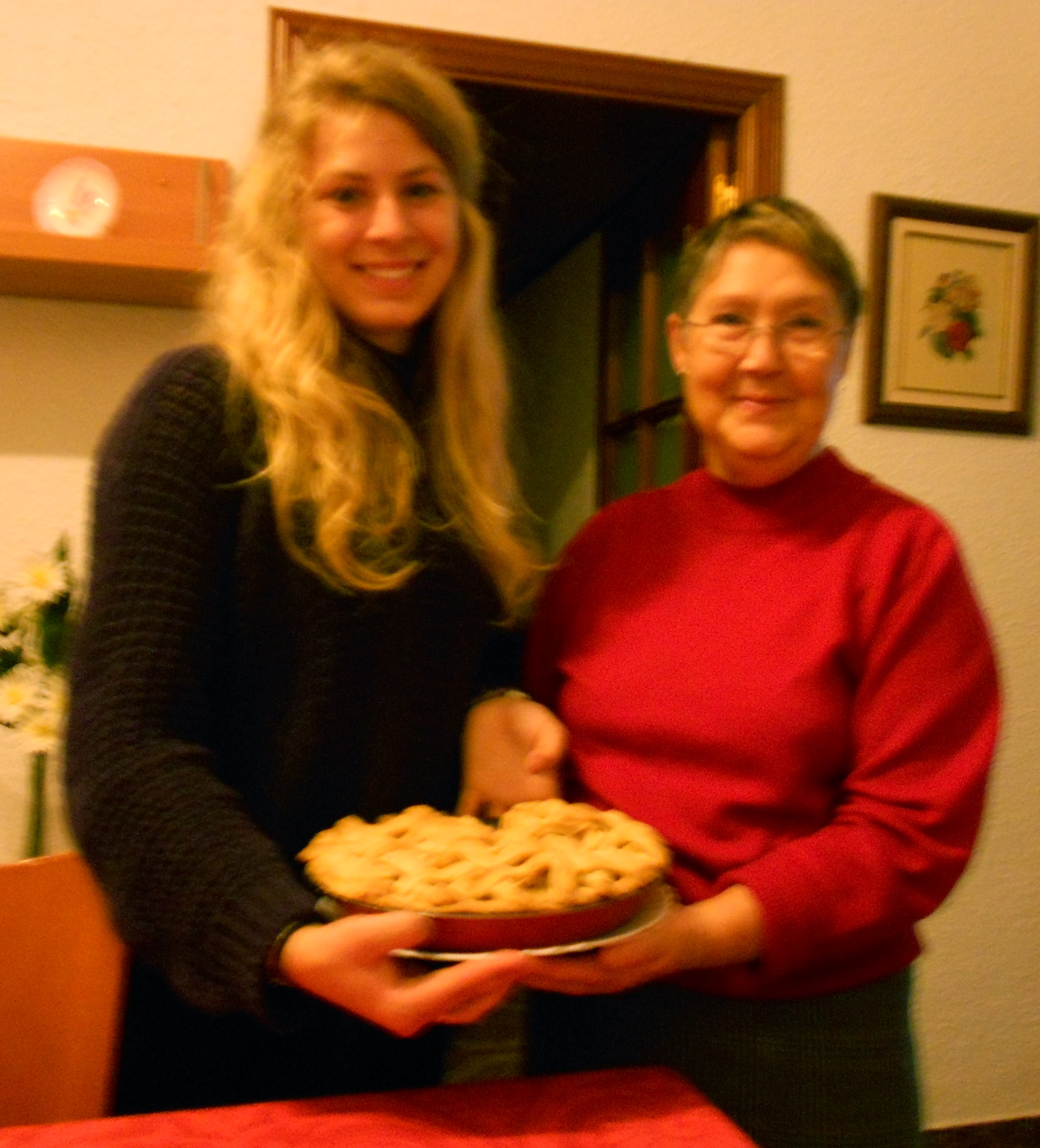
(My madre and I when I showed her my family's apple pie recipe)
Tuesday July 03, 2012
This past week Jim was out working on the garden, and he picked these BEAUTIFUL Wild Lilies. We already had some Garlic Scapes in the kitchen, so I decided to arrange them. Look at the pictures of the two. They make for a gorgeous pair, don't you think?
A match made in heaven!


Wild Lilies and Garlic Scapes add a touch of Summer to the Heirloom Meals kitchen.
Page 19 of 88 pages ‹ First < 17 18 19 20 21 > Last ›







